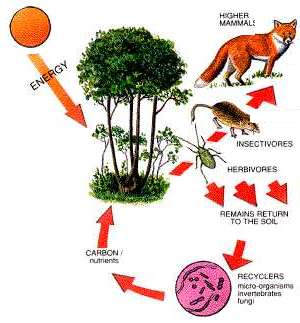Wildlife gardening
The essence of wildlife gardening is to garden in harmony with nature, rather than try to bludgeon it into submission with brute force and powerful chemicals. Nature has taken millions of years to evolve a system that is a miracle of balance and efficiency. It relies on plants, which capture energy from the sun and in turn feed a whole chain of animals. The remains of plants and animals are recycled, helped by a myriad tiny creatures and organisms in the soil. As a result ancient woodlands and grasslands that have never seen artificial fertilisers are as productive now as they were thousands of years ago. It is an intricate system involving all kinds of relationships between plants and animals and between one animal and another, many of which we still do not understand fully.
Encouraging wildlife
The key to a wildlife-rich garden is to intervene in the natural system only when necessary, to steer nature the way we want. By limiting intervention in this way we allow nature to express itself in all its diversity. That does not mean just allowing it to 'run wild', because there are many ways to keep pests under control apart from poisoning them – see light-touch gardening and pest control for more.
It also means recycling garden wastes and developing the natural fertility of the soil. This form of gardening is not only good for wildlife, it is also less wasteful of the world's natural resources than 'traditional' chemical gardening.
Wildlife gardening is a gain for the gardener as well as for wildlife. It can offer as much in terms of colour, scent and form as traditional gardening, and at the same time brings new delights in the form of abundant wildlife, both the obvious butterflies and birds and also, if you care to look out for them, wary nocturnal visitors like hedgehogs and a huge variety of mini-beasts.

Wildlife ponds
If there is one feature every wildlife garden should have it is a pond. Even a small one can serve as a breeding site for frogs and damselflies and, with the loss of many farm ponds, garden ponds are now a stronghold for frogs and newts.
Provided that ornamental fish are not introduced, it will very quickly attract small pond creatures like pond skaters and water boatmen and be full of interest throughout the summer.
Prefabricated ponds can be bought from garden centres or you can design and build a customised pond using a liner: for guidance click here.
Choosing the right plants
Even without changing the way you manage your garden, you can make an enormous difference to its wildlife value just by choosing the right plants. Native plants are best but most are too vigorous for gardens and there are many non-native plants that are valuable for wildlife as well – click on the links at the left for lists.
Remember also that 'improved' varieties of plant offered in garden centres may have been made more attractive to people at the expense of wildlife value. Double-flowered plants, for example, produce no nectar or pollen so are useless to nectar-feeding insects such as butterflies or bees.
